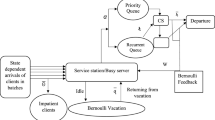Abstract
We study a model of controlled queueing network, which operates and makes control decisions in discrete time. An underlying random network mode determines the set of available controls in each time slot. Each control decision “produces” a certain vector of “commodities”; it also has associated “traditional” queueing control effect, i.e., it determines traffic (customer) arrival rates, service rates at the nodes, and random routing of processed customers among the nodes. The problem is to find a dynamic control strategy which maximizes a concave utility function H(X), where X is the average value of commodity vector, subject to the constraint that network queues remain stable.
We introduce a dynamic control algorithm, which we call Greedy Primal-Dual (GPD) algorithm, and prove its asymptotic optimality. We show that our network model and GPD algorithm accommodate a wide range of applications. As one example, we consider the problem of congestion control of networks where both traffic sources and network processing nodes may be randomly time-varying and interdependent. We also discuss a variety of resource allocation problems in wireless networks, which in particular involve average power consumption constraints and/or optimization, as well as traffic rate constraints.
Similar content being viewed by others
References
M. Andrews, K. Kumaran, K. Ramanan, A.L. Stolyar, R. Vijayakumar and P. Whiting, Providing quality of service over a shared wireless link, IEEE Communications Magazine 39(2) (2001) 150–154.
M. Andrews, L. Qian and A.L. Stolyar, Optimal utility based multi-user throughput allocation subject to throughput constraints, in: Proceeding of INFOCOM’2005, Miami, March 13–17, 2005.
R. Agrawal and V. Subramanian, Optimality of certain channel aware scheduling policies, in: Proc. of the 40th Annual Allerton Conference on Communication, Control, and Computing, (Monticello, Illinois, USA, October 2002).
J.G. Dai and W. Lin, Maximum pressure policies in stochastic processing networks, Operations Research 53(2) (2005) 197–218.
S.N. Ethier and T.G. Kurtz, Markov Processes: Characterization and Convergence, (John Wiley and Sons, New York, 1986).
A. Eryilmaz and R. Srikant, Fair resource allocation in wireless networks using Queue-length-based scheduling and congestion control, in: Proceedings of INFOCOM’2005, Miami, March 13–17, 2005.
J.M. Harrison. Brownian Motion and Stochastic Flow Systems, (Wiley, 1985).
A. Jalali, R. Padovani and R. Pankaj, Data Throughput of CDMA-HDR, a high efficiency—high data rate personal communication wireless system, in: Proc. of the IEEE Semiannual Vehicular Technology Conference, VTC2000-Spring (Tokyo, Japan, May 2000).
L.V. Kantorovich and G.P. Akilov, Functional Analysis, 2nd ed. (Pergamon Press, New York, 1982).
F.P. Kelly, A.K. Maullo and D.K.H. Tan, Rate control in communication networks: Shadow prices, proportional fairness and stability, Journal of the Operational Research Society 49 (1998) 237–252.
F.P. Kelly, Fairness and stability of end-to-end congestion control, European Journal of Control 9 (2003) 159–176.
T. Klein and H. Viswanathan, Centralized power control for multi-hop wireless networks, (2003), submitted.
S. Karlin, Mathematical Methods in Games, Programming, and Economics (Dover, New York, 1992).
S. Liu, T. Basar and R. Srikant, Controlling the Internet: A survey and some new results (2003), preprint.
X. Liu, E.K.P. Chong and N.B. Shroff, A framework for opportunistic scheduling in wireless networks, Computer Networks 41 (2003) 451–474.
S. Low, A duality model of TCP and queue management algorithms, IEEE/ACM Transactions on Networkin 11(4) (2003) 525–536.
R.T. Rockafellar, Convex Analysis, Princeton Univ. Press, 1970.
R. Srikant, The Mathematics of Internet Congestion Control (Birkhauser, 2004).
A.L. Stolyar, On the stability of multiclass queueing networks: A Relaxed Sufficient Condition via Limiting Fluid Processes, Markov Processes and Related Fields 1(4) (1995) 491–512.
A.L. Stolyar, MaxWeight scheduling in a generalized switch: State space collapse and workload minimization in heavy traffic, Annals of Applied Probability 14(1) (2004) 1–53.
A.L. Stolyar, On the asymptotic optimality of the gradient scheduling algorithm for multi-user throughput allocation, Operations Research 53(1) (2005) 12–25.
L. Tassiulas and A. Ephremides, Stability properties of constrained queueing systems and scheduling policies for maximum throughput in multihop radio networks, IEEE Transactions on Automatic Control 37 (1992) 1936–1948.
L. Tassiulas and P.P. Bhattacharya, Allocation of interdependent resources for maximal throughput, Commun. Statist.—Stochastic Models 16 (2000) 27–48.
D. Tse and S. Hanly, Multi-access fading channels: Part I: Polymatroid structure, optimal resource allocation and throughput capacities, IEEE Transactions on Information Theory 44(7) (1998) 2796–2815.
P. Viswanath, D. Tse and R. Laroia, Opportunistic beamforming using dumb antennas, IEEE Transactions on Information Theory 48(6) (2002) 1277–1294.
J.T. Wen and M. Arcak, A unifying passivity framework for network flow control, IEEE Transactions on Automatic Control 49(2) (2004) 162–174.
E.M. Yeh and A.S. Cohen, Throughput and delay optimal resource allocation in multiaccess fading channels, in: Proceedings of ISIT, (Yokohama, Japan, June–July 2003).
Author information
Authors and Affiliations
Corresponding author
Rights and permissions
About this article
Cite this article
Stolyar, A.L. Maximizing Queueing Network Utility Subject to Stability: Greedy Primal-Dual Algorithm. Queueing Syst 50, 401–457 (2005). https://doi.org/10.1007/s11134-005-1450-0
Received:
Revised:
Issue Date:
DOI: https://doi.org/10.1007/s11134-005-1450-0




